engine HUMMER H2 2007 User Guide
[x] Cancel search | Manufacturer: HUMMER, Model Year: 2007, Model line: H2, Model: HUMMER H2 2007Pages: 570, PDF Size: 3.34 MB
Page 122 of 570

Your vehicle has a Computer-Controlled
Cranking System. This feature assists in
starting the engine and protects components. If
the ignition key is turned to the START position,
and then released when the engine begins
cranking, the engine will continue cranking for a
few seconds or until the vehicle starts. If the
engine does not start and the key is held in
START for many seconds, cranking will be
stopped after 15 seconds to prevent cranking
motor damage. To prevent gear damage, this
system also prevents cranking if the engine is
already running. Engine cranking can be
stopped by turning the ignition switch to the
ACCESSORY or LOCK position.
Notice:Cranking the engine for long periods
of time, by returning the key to the START
position immediately after cranking has ended,
can overheat and damage the cranking
motor, and drain the battery. Wait at least
15 seconds between each try, to allow
the cranking motor to cool down.2. If the engine does not start after 5-10 seconds,
especially in very cold weather (below 0°F
or−18°C), it could be �ooded with too much
gasoline. Try pushing the accelerator
pedal all the way to the �oor and holding it
there as you hold the key in START for up to
a maximum of 15 seconds. Wait at least
15 seconds between each try, to allow the
cranking motor to cool down. When the engine
starts, let go of the key and accelerator. If
the vehicle starts brie�y but then stops again,
do the same thing. This clears the extra
gasoline from the engine. Do not race the
engine immediately after starting it. Operate
the engine and transmission gently until the oil
warms up and lubricates all moving parts.
Notice:Your engine is designed to work with
the electronics in your vehicle. If you add
electrical parts or accessories, you could
change the way the engine operates. Before
adding electrical equipment, check with
your dealer. If you do not, your engine might
not perform properly. Any resulting damage
would not be covered by your vehicle’s
warranty.
122
Page 123 of 570
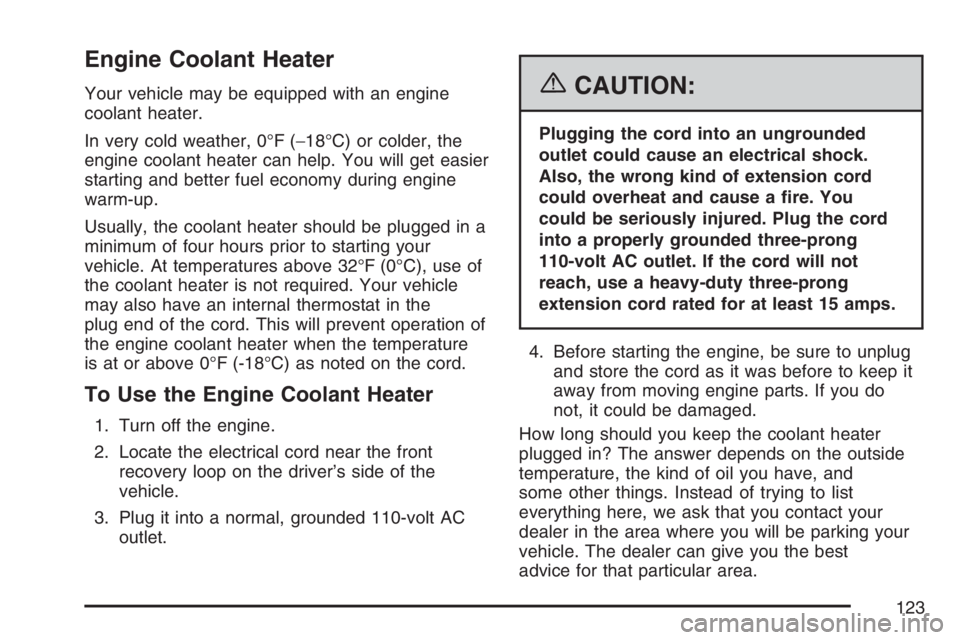
Engine Coolant Heater
Your vehicle may be equipped with an engine
coolant heater.
In very cold weather, 0°F (−18°C) or colder, the
engine coolant heater can help. You will get easier
starting and better fuel economy during engine
warm-up.
Usually, the coolant heater should be plugged in a
minimum of four hours prior to starting your
vehicle. At temperatures above 32°F (0°C), use of
the coolant heater is not required. Your vehicle
may also have an internal thermostat in the
plug end of the cord. This will prevent operation of
the engine coolant heater when the temperature
is at or above 0°F (-18°C) as noted on the cord.
To Use the Engine Coolant Heater
1. Turn off the engine.
2. Locate the electrical cord near the front
recovery loop on the driver’s side of the
vehicle.
3. Plug it into a normal, grounded 110-volt AC
outlet.
{CAUTION:
Plugging the cord into an ungrounded
outlet could cause an electrical shock.
Also, the wrong kind of extension cord
could overheat and cause a �re. You
could be seriously injured. Plug the cord
into a properly grounded three-prong
110-volt AC outlet. If the cord will not
reach, use a heavy-duty three-prong
extension cord rated for at least 15 amps.
4. Before starting the engine, be sure to unplug
and store the cord as it was before to keep it
away from moving engine parts. If you do
not, it could be damaged.
How long should you keep the coolant heater
plugged in? The answer depends on the outside
temperature, the kind of oil you have, and
some other things. Instead of trying to list
everything here, we ask that you contact your
dealer in the area where you will be parking your
vehicle. The dealer can give you the best
advice for that particular area.
123
Page 124 of 570

Automatic Transmission Operation
Your vehicle is equipped with an automatic
transmission and features an electronic shift
position indicator located within the instrument
panel cluster.
There are several different positions for your
shift lever.
PARK (P):This position locks your drive wheels. It
is the best position to use when you start your
engine because your vehicle cannot move easily.
{CAUTION:
It is dangerous to get out of your vehicle
if the shift lever is not fully in PARK (P)
with the parking brake �rmly set. Your
vehicle can roll.
Do not leave your vehicle when the engine
is running unless you have to. If you have
left the engine running, the vehicle can
move suddenly. You or others could be
injured. To be sure your vehicle will not
move, even when you are on fairly level
ground, always set your parking brake
and move the shift lever to PARK (P). See
Shifting Into Park (P) on page 134.Ifyou
are pulling a trailer, seeTowing a Trailer
on page 374.
124
Page 125 of 570

{CAUTION:
Shifting the transfer case to NEUTRAL
can cause your vehicle to roll even if the
transmission is in PARK (P). You or
someone else could be seriously injured.
Be sure to set the parking brake before
placing the transfer case in NEUTRAL.
SeeParking Brake on page 133.
REVERSE (R):Use this gear to back up.
Notice:Shifting to REVERSE (R) while your
vehicle is moving forward could damage
the transmission. The repairs would not be
covered by your warranty. Shift to
REVERSE (R) only after your vehicle is
stopped.
To rock your vehicle back and forth to get out
of snow, ice or sand without damaging your
transmission, seeIf Your Vehicle is Stuck in
Sand, Mud, Ice, or Snow on page 357.NEUTRAL (N):In this position, your engine does
not connect with the drive wheels. To restart when
you are already moving, use NEUTRAL (N) only.
{CAUTION:
Shifting into a drive gear while your
engine is running at high speed is
dangerous. Unless your foot is �rmly on
the brake pedal, your vehicle could move
very rapidly. You could lose control and
hit people or objects. Do not shift into a
drive gear while your engine is running at
high speed.
Notice:Shifting out of PARK (P) or
NEUTRAL (N) with the engine running at high
speed may damage the transmission. The
repairs would not be covered by your warranty.
Be sure the engine is not running at high
speed when shifting your vehicle.
125
Page 127 of 570

FIRST (1):This position reduces vehicle speed
even more than SECOND (2) without using
your brakes. You can use it on very steep hills, or
in deep snow or mud. If the shift lever is put in
FIRST (1) while the vehicle is moving forward, the
transmission will not shift into �rst gear until the
vehicle is going slowly enough.
Notice:Spinning the tires or holding the
vehicle in one place on a hill using only the
accelerator pedal may damage the
transmission. The repair will not be covered by
your warranty. If you are stuck, do not spin
the tires. When stopping on a hill, use the
brakes to hold the vehicle in place.
On cold days, approximately 32°F (0°C) or colder,
your transmission is designed to shift differently
until the engine reaches normal operating
temperature. This is intended to improve heater
performance.Tow/Haul Mode
Your vehicle is equipped
with a tow/haul mode.
The button is located on
the instrument panel
to the right of the
steering wheel.
You can use this feature to assist when towing or
hauling a heavy load. See “Tow/Haul Mode”
underTowing a Trailer on page 374for more
information.
127
Page 128 of 570
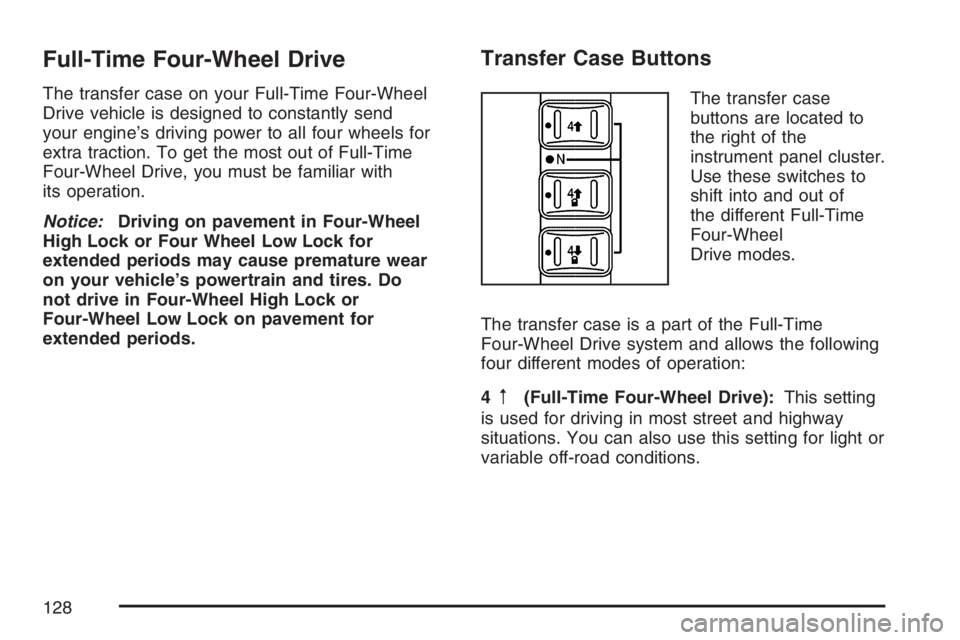
Full-Time Four-Wheel Drive
The transfer case on your Full-Time Four-Wheel
Drive vehicle is designed to constantly send
your engine’s driving power to all four wheels for
extra traction. To get the most out of Full-Time
Four-Wheel Drive, you must be familiar with
its operation.
Notice:Driving on pavement in Four-Wheel
High Lock or Four Wheel Low Lock for
extended periods may cause premature wear
on your vehicle’s powertrain and tires. Do
not drive in Four-Wheel High Lock or
Four-Wheel Low Lock on pavement for
extended periods.
Transfer Case Buttons
The transfer case
buttons are located to
the right of the
instrument panel cluster.
Use these switches to
shift into and out of
the different Full-Time
Four-Wheel
Drive modes.
The transfer case is a part of the Full-Time
Four-Wheel Drive system and allows the following
four different modes of operation:
4
m(Full-Time Four-Wheel Drive):This setting
is used for driving in most street and highway
situations. You can also use this setting for light or
variable off-road conditions.
128
Page 130 of 570
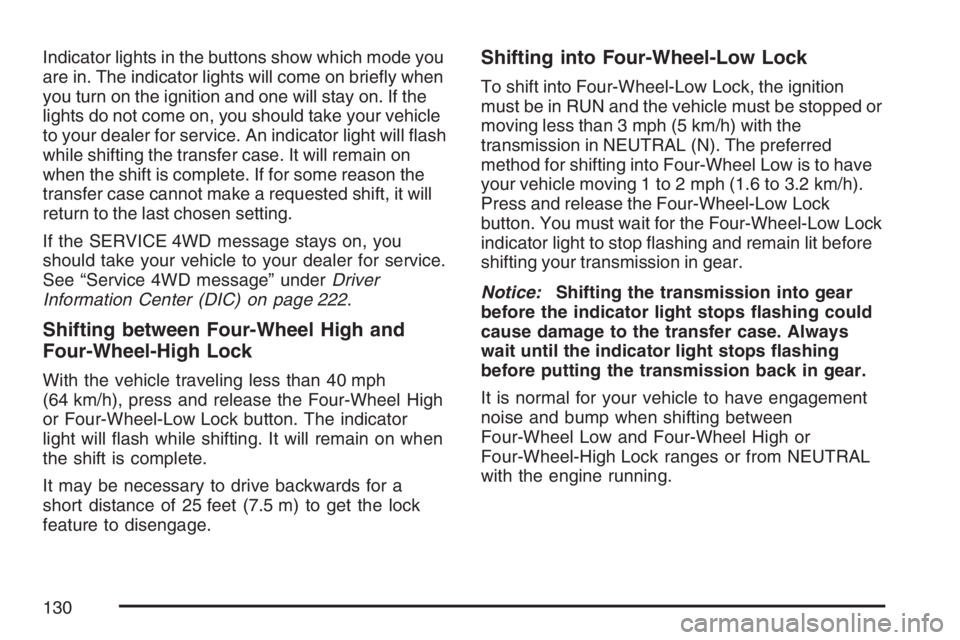
Indicator lights in the buttons show which mode you
are in. The indicator lights will come on brie�y when
you turn on the ignition and one will stay on. If the
lights do not come on, you should take your vehicle
to your dealer for service. An indicator light will �ash
while shifting the transfer case. It will remain on
when the shift is complete. If for some reason the
transfer case cannot make a requested shift, it will
return to the last chosen setting.
If the SERVICE 4WD message stays on, you
should take your vehicle to your dealer for service.
See “Service 4WD message” underDriver
Information Center (DIC) on page 222.
Shifting between Four-Wheel High and
Four-Wheel-High Lock
With the vehicle traveling less than 40 mph
(64 km/h), press and release the Four-Wheel High
or Four-Wheel-Low Lock button. The indicator
light will �ash while shifting. It will remain on when
the shift is complete.
It may be necessary to drive backwards for a
short distance of 25 feet (7.5 m) to get the lock
feature to disengage.
Shifting into Four-Wheel-Low Lock
To shift into Four-Wheel-Low Lock, the ignition
must be in RUN and the vehicle must be stopped or
moving less than 3 mph (5 km/h) with the
transmission in NEUTRAL (N). The preferred
method for shifting into Four-Wheel Low is to have
your vehicle moving 1 to 2 mph (1.6 to 3.2 km/h).
Press and release the Four-Wheel-Low Lock
button. You must wait for the Four-Wheel-Low Lock
indicator light to stop �ashing and remain lit before
shifting your transmission in gear.
Notice:Shifting the transmission into gear
before the indicator light stops �ashing could
cause damage to the transfer case. Always
wait until the indicator light stops �ashing
before putting the transmission back in gear.
It is normal for your vehicle to have engagement
noise and bump when shifting between
Four-Wheel Low and Four-Wheel High or
Four-Wheel-High Lock ranges or from NEUTRAL
with the engine running.
130
Page 131 of 570
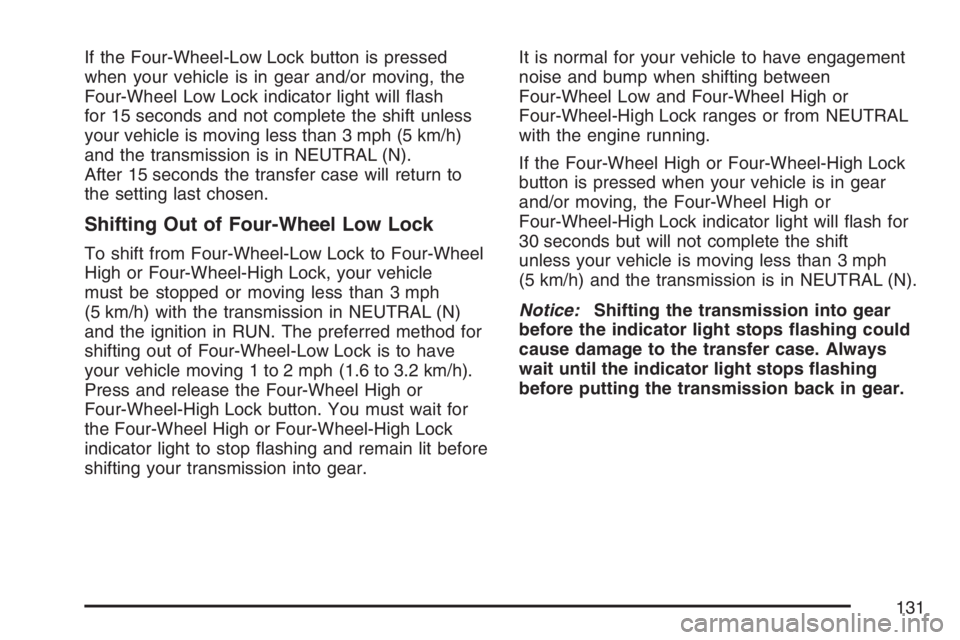
If the Four-Wheel-Low Lock button is pressed
when your vehicle is in gear and/or moving, the
Four-Wheel Low Lock indicator light will �ash
for 15 seconds and not complete the shift unless
your vehicle is moving less than 3 mph (5 km/h)
and the transmission is in NEUTRAL (N).
After 15 seconds the transfer case will return to
the setting last chosen.
Shifting Out of Four-Wheel Low Lock
To shift from Four-Wheel-Low Lock to Four-Wheel
High or Four-Wheel-High Lock, your vehicle
must be stopped or moving less than 3 mph
(5 km/h) with the transmission in NEUTRAL (N)
and the ignition in RUN. The preferred method for
shifting out of Four-Wheel-Low Lock is to have
your vehicle moving 1 to 2 mph (1.6 to 3.2 km/h).
Press and release the Four-Wheel High or
Four-Wheel-High Lock button. You must wait for
the Four-Wheel High or Four-Wheel-High Lock
indicator light to stop �ashing and remain lit before
shifting your transmission into gear.It is normal for your vehicle to have engagement
noise and bump when shifting between
Four-Wheel Low and Four-Wheel High or
Four-Wheel-High Lock ranges or from NEUTRAL
with the engine running.
If the Four-Wheel High or Four-Wheel-High Lock
button is pressed when your vehicle is in gear
and/or moving, the Four-Wheel High or
Four-Wheel-High Lock indicator light will �ash for
30 seconds but will not complete the shift
unless your vehicle is moving less than 3 mph
(5 km/h) and the transmission is in NEUTRAL (N).
Notice:Shifting the transmission into gear
before the indicator light stops �ashing could
cause damage to the transfer case. Always
wait until the indicator light stops �ashing
before putting the transmission back in gear.
131
Page 132 of 570
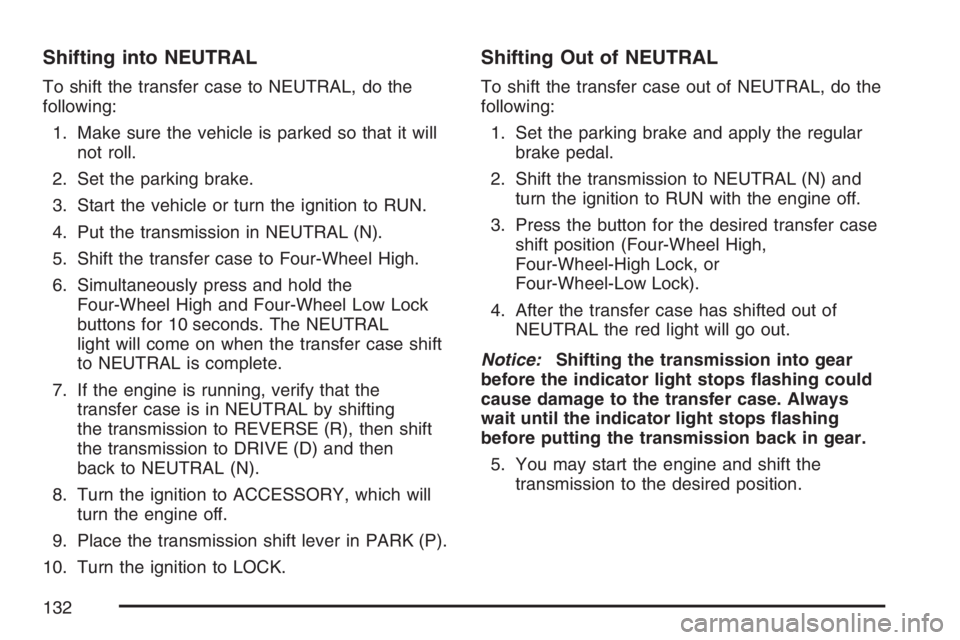
Shifting into NEUTRAL
To shift the transfer case to NEUTRAL, do the
following:
1. Make sure the vehicle is parked so that it will
not roll.
2. Set the parking brake.
3. Start the vehicle or turn the ignition to RUN.
4. Put the transmission in NEUTRAL (N).
5. Shift the transfer case to Four-Wheel High.
6. Simultaneously press and hold the
Four-Wheel High and Four-Wheel Low Lock
buttons for 10 seconds. The NEUTRAL
light will come on when the transfer case shift
to NEUTRAL is complete.
7. If the engine is running, verify that the
transfer case is in NEUTRAL by shifting
the transmission to REVERSE (R), then shift
the transmission to DRIVE (D) and then
back to NEUTRAL (N).
8. Turn the ignition to ACCESSORY, which will
turn the engine off.
9. Place the transmission shift lever in PARK (P).
10. Turn the ignition to LOCK.
Shifting Out of NEUTRAL
To shift the transfer case out of NEUTRAL, do the
following:
1. Set the parking brake and apply the regular
brake pedal.
2. Shift the transmission to NEUTRAL (N) and
turn the ignition to RUN with the engine off.
3. Press the button for the desired transfer case
shift position (Four-Wheel High,
Four-Wheel-High Lock, or
Four-Wheel-Low Lock).
4. After the transfer case has shifted out of
NEUTRAL the red light will go out.
Notice:Shifting the transmission into gear
before the indicator light stops �ashing could
cause damage to the transfer case. Always
wait until the indicator light stops �ashing
before putting the transmission back in gear.
5. You may start the engine and shift the
transmission to the desired position.
132
Page 134 of 570
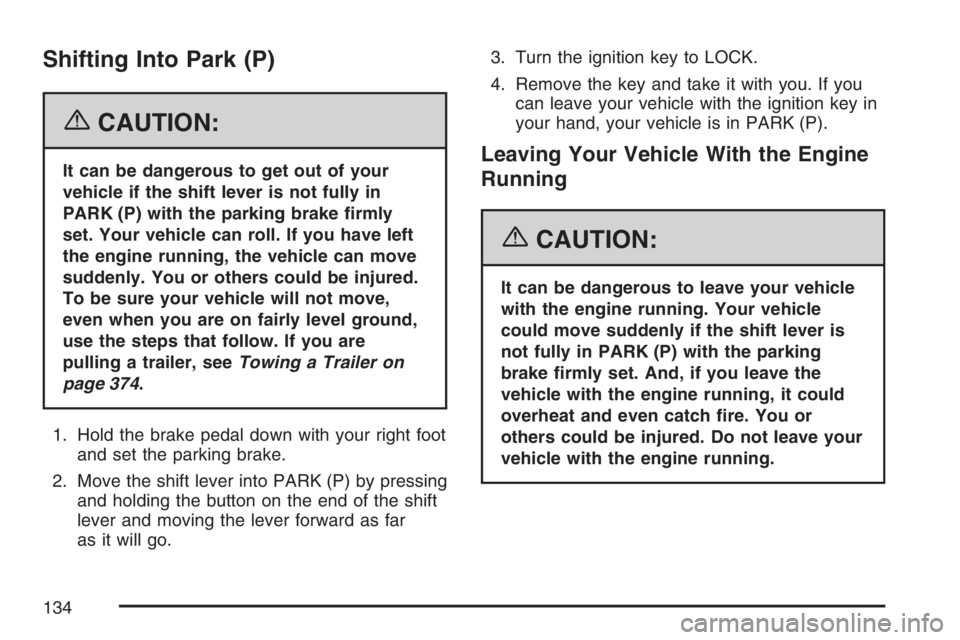
Shifting Into Park (P)
{CAUTION:
It can be dangerous to get out of your
vehicle if the shift lever is not fully in
PARK (P) with the parking brake �rmly
set. Your vehicle can roll. If you have left
the engine running, the vehicle can move
suddenly. You or others could be injured.
To be sure your vehicle will not move,
even when you are on fairly level ground,
use the steps that follow. If you are
pulling a trailer, seeTowing a Trailer on
page 374.
1. Hold the brake pedal down with your right foot
and set the parking brake.
2. Move the shift lever into PARK (P) by pressing
and holding the button on the end of the shift
lever and moving the lever forward as far
as it will go.3. Turn the ignition key to LOCK.
4. Remove the key and take it with you. If you
can leave your vehicle with the ignition key in
your hand, your vehicle is in PARK (P).Leaving Your Vehicle With the Engine
Running
{CAUTION:
It can be dangerous to leave your vehicle
with the engine running. Your vehicle
could move suddenly if the shift lever is
not fully in PARK (P) with the parking
brake �rmly set. And, if you leave the
vehicle with the engine running, it could
overheat and even catch �re. You or
others could be injured. Do not leave your
vehicle with the engine running.
134